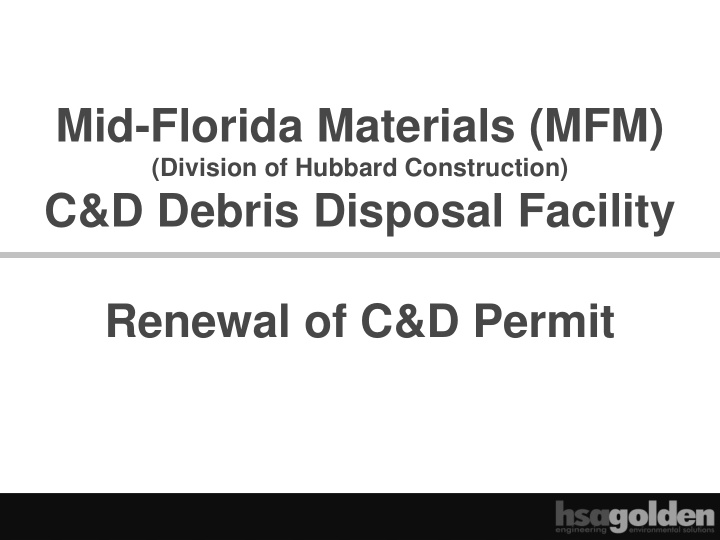



Mid-Florida Materials (MFM) (Division of Hubbard Construction) C&D Debris Disposal Facility Renewal of C&D Permit
Presentation Overview • Business of Hubbard Construction and MFM • History of MFM C&D Disposal Facility • Location • Requested Permit Renewal • Existing Wekiva Study Area Protections
Business of Hubbard Construction and Mid-Florida Materials • Hubbard started as a Central Florida business in 1920. • Main business is roadway construction. • Employs 470 people. • MFM is a division of Hubbard. • Main business of MFM is borrow pits, C&D debris disposal, and recycling. • MFM accepts C&D debris: steel*, glass, brick, concrete*, asphalt material, pipe, gypsum wallboard, lumber, yard trash*, rocks, soil, land clearing debris (trees)*, clean cardboard*, paper, plastic, wood, and metal scraps*. * Materials that are recycled.
History of MFM C&D Disposal Facility • 1960 – Borrow pit began • 1984 – Started filling in borrow pit with C&D Debris • Orange County Excavation/Fill Permit 1991 - 2012 • 220 Acres – C&D Facility approved in 2000; permit renewal 2007 • For 29 years, has been compatible with surrounding land uses (borrow pits/landfills/agricultural) and neighbors • Approved permits from FDEP and Orange County • Excellent compliance record – no odor or groundwater quality issues • Recycles 30% of debris: wood, yard trash, concrete, and metals • Estimated 81 years of life at 2012 intake rates
MFM C&D Disposal Facility MFM C&D Location 3602 Golden Gem Rd. Zellwood, FL
Facility Location
MFM C&D Facility Site Plan
MFM C&D Disposal Facility Working Face Borrow Pit Concrete Recycling Yard Trash Recycling
MFM C&D Disposal Facility Requested Permit Renewal • All permit renewal requirements of the Orange County Code (Chapter 32, Article V) have been met by the Applicant. 1. Application submitted 90 days prior to expiration date (December 3, 2012) – submitted application on May 19, 2011 [Section 32-214(10(g)]. 2. Renewal groundwater sampling event completed 6 months prior to renewal. 3. Re-evaluation of base grade elevations vs. water table levels completed.
MFM C&D Disposal Facility Requested Permit Renewal • Permit renewals are considered a formality, i.e. a Public Hearing is not required, nor DRC or BZA review, unless the EPD Manager determines that there has been a substantial deviation from the terms and conditions of the permit. The EDP Manager has determined no substantial deviation. [Section 32-214(n)]. • Wekiva Study Area provisions [Section 32-216(c)] do not apply to this legally existing C&D disposal facility prior to the effective date of May 1, 2009 [Section 32-223]. • There is no record, or history, of violations or non-compliance to Orange County Code Chapter 32 [Section 32-217(d)(5)]. • We accept Orange County EPD’s recommendation for permit renewal approval.
Existing Wekiva Study Area Protections • Low Recharge Area – Site specific geologic studies found 70 to 100 feet of clayey sediments under the site to protect the Floridan Aquifer. • Natural site geology attenuates leakage through the waste as shown by 15 years of clean Groundwater Quality Tests. • Groundwater monitoring wells are tested every 6 months. • C&D wastes are not a nutrient concern. • Stormwater Management System of ponds exceeds Wekiva Pollution Abatement standards. • Soil Cover over the C&D reduces infiltration. • Ongoing Operational Best Management Practices. • Site will be a 220 acre open space or park at closure.
C&D Debris vs. Wekiva River Pollution Sources Wekiva River Nutrient Pollution Sources MFM C&D Facility is not a pollution source to the Wekiva River C&D Debris Recycled Materials Other Inert Materials Steel Glass (septic tanks) Concrete Brick Asphalt material Pipe Lumber Gypsum wallboard Yard trash Rocks and soil Land clearing Paper debris (trees) Plastic Clean cardboard Source: MACTEC’s Final Report Wekiva River Basin Nitrate Sourcing Study for FDEP and SJRWMD, March 2010
Questions?
Hydrogeologic Cross Section On-site Studies Prove Low Recharge
Landfill Operational Controls • Noise Control Orange County Code Enforcement • Odor Control • Monthly Inspections • Noise • Vibration Control • Odor • Dust Control and Visual Emissions • Dust • Litter Control • Litter • Lighting and Glare • Truck Traffic • Waste Screening – Prohibit • Annual Reporting non-C&D wastes FDEP Oversight • Truck Traffic Controls • Quarterly on-Site Inspections • Emergency Plans – Fire, Hurricane • Annual Reporting • Setbacks and Visual Buffering • Complaint Response MFM has an excellent • Odor and Groundwater Quality Rules • Quarterly and Semiannual Reports compliance record
FDEP Definition: Construction & Demolition Debris “Construction and Demolition Debris” means discarded materials generally considered to be not water soluble and non-hazardous in nature, including but not limited to steel, glass, brick concrete, asphalt material, pipe, gypsum wallboard, lumber, land clearing debris, yard trash, and unpainted, non-treated wood scraps, from the construction or destruction of a structure as part of a construction or demolition project or from the renovation of a structure, including such debris from construction of structures at a site remote from the construction or demolition project site.
Protection Area MFM C&D Study Area
46 Wekiva Protection Area The facility is 441 not located in the Wekiva Protection Area Orange County
Wekiva Florida Geological Survey Study Area Disclaimer – RI #104: Primary “Application of the (“more vulnerable”) vulnerability map on the order of greater than 0.75 Secondary square miles (480 acres) is on (“vulnerable”) more appropriate. The WAVA Vulnerability map is no Tertiary (‘less vulnerable”) substitute for a site-specific hydrogeologic investigation.”
Recommend
More recommend